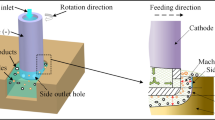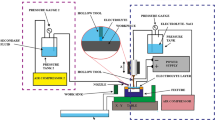Abstract
This paper presents a grinding wheel with an internal cooling lubricant supply (GIC). The cooling lubricant is supplied through channels inside the grinding wheel instead of conventional supply using external nozzles. With the GIC, direct coolant supply into the contact zone is possible. The hydraulic design of the GIC is similar to that of a centrifugal pump impeller. The design process is supported by simulation of fluid dynamics. First tests show that the GIC is able to supply the coolant at different flow rates with cutting speeds up to 60 m/s.












Similar content being viewed by others
References
Grof E (1977) Beitrag zur Klärung des Trennvorganges beim Schleifen von Metallen. Dissertation. TU München 1977
Brinksmeier E, Heinzel C, Wittmann M (1999) Friction, cooling and lubrication in grinding. Annal CIRP 48(2):581–598
Brinksmeier E, Wittmann M, Klocke F, Beck T (2000) Strategien zur Kühlschmierstoff-Zuführung beim Schleifen. Schleiftechnisches Kolloquium, Universität Bremen Paper Nr. 10
Brinksmeier E, Wilke T (2004) Erfassung und Vermeidung thermischer Randzonenbeeinflussung beim Schleifen. Stuttgart, Konferenzbericht Moderne Schleiftechnologie und Feinstbearbeitung
Meyer L, Heinzel C, Brinksmeier E (2005) Analysis and optimization of coolant supply conditions in grinding. Product Eng XII(2):27–30
Treffert C (1995) Hochgeschwindigkeitsschleifen mit galvanisch gebundenen CBN Schleifscheiben. Dissertation. Fakultät für Maschinenwesen RWTH Aachen
Klocke F, Beck T (1997) Zufuhrsysteme für den anforderungsgerechten Kühlschmierstoffeinsatz. Schleiftechnisches Kolloquium, VDI-Verlag
Wittmann M (2007) Bedarfsgerechte Kühlschmierung beim Schleifen. Dissertation. Universität Bremen
Saljé E, Riefenstahl J (1982) Kühlmittelzufuhr durch die schleifscheibe beim innenrundschleifen. Industrie-Anzeiger 43(104):39–40
Klocke F (1998) Gleiche Oberflächenqualität mit Innenkühlung. Industrieanzeiger 37/98:68
Martens R, Maier R, Bettingen A (1998) Innenkühlung beim CBN-Schleifen. VDI-Z 140 Nr. 1/2 1998:42-44
Nguyen T, Zhang L (2008) Performance of a new segmented grinding wheel system. Int J Mach Tool Manuf 49(1–3):291–296
Aurich JC, Sudermann H, Hellmann D-H, Roclawski H (2006) Interne Schleifölzufuhr beim Hochleistungsschleifen. wt Werkstattstechnik online 96-11/12:810–813
Gülich JF (2004) Kreiselpumpen. Springer
Sprengler H (1976) Technisches Handbuch Pumpen. VEB
Pfleiderer C (1961) Die Kreiselpumpen für Flüssigkeiten und Gase. Springer
Tillak P (1998) Förderverhalten von Kreiselpumpen bei viskosen, gasbeladenen Flüssigkeiten. Dissertation. TU Kaiserslautern
Sauer M (2002) Einfluß der Zuströmung auf das Förderverhalten von Kreiselpumpen radialer Bauart bei Flüssigkeits-/Gasförderung. Dissertation. TU Kaiserslautern
Acknowledgments
This research project is kindly funded by the “Stiftung Rheinland-Pfalz für Innovation”. The authors also would like to thank Dr.-Ing. T. Magg, Diamantgesellschaft TESCH GmbH, Ludwigsburg, for his technical support.
Author information
Authors and Affiliations
Corresponding author
Rights and permissions
About this article
Cite this article
Aurich, J.C., Kirsch, B., Herzenstiel, P. et al. Hydraulic design of a grinding wheel with an internal cooling lubricant supply. Prod. Eng. Res. Devel. 5, 119–126 (2011). https://doi.org/10.1007/s11740-010-0289-3
Received:
Accepted:
Published:
Issue Date:
DOI: https://doi.org/10.1007/s11740-010-0289-3




